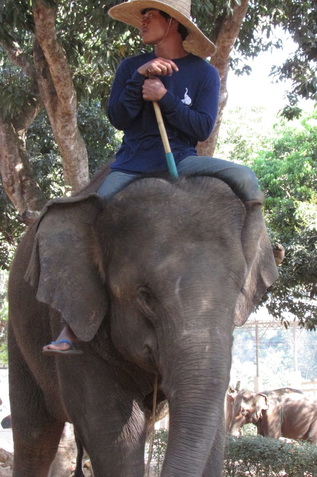|
I have travelled in Thailand extensively,
and lived in Chiang Mai for almost 7 months. Here is my tips and advice for making the most of your trip here! |
Scroll down to read:
~ 5 Things to do in Chiang Mai for Free ~ Elephant Sanctuaries: Choose Wisely! |
5 Things to do in Chiang Mai for Free
|
Hike Doi Suthep Doi Suthep Mountain overlooks Chiang Mai city and can be seen as you fly in to the airport. While the mountain is hard to miss, most visitors aren’t aware of the most special way to access it. The hiking trail runs from the end of Doi Suthep road and takes you through the beautiful Wat Pha Lat temple, a tranquil place to rest before carrying on your journey. The whole hike takes around 2 hours, and leads you to the famous Wat Phratat temple at the top, which is also free to visit. Explore The Old City Chiang Mai city is 700 years old and was once fortified. The old town is surrounded by a moat and has 5 ancient brick ‘gates’. The streets inside the moat are a delight to wander around and get lost in. The 3 Kings Monument square is worth a look, and where the museums are (not free!) There are temples around every corner (all free to visit), shops and cafes galore, spa and massage parlours to enjoy. Don’t miss Moonmuang Soi 6 for a bohemian feel. If you like a walk with more direction, the entire moat can be marched in around an hour, and is quite enjoyable with many trees lining the way. Visit Chedi Luang Temple This famous Buddhist temple right in the middle of Chiang Mai historic centre was built between the 14th and 15th centuries. Of all the large temples in the centre, this one is the most beautiful and tranquil to walk around. Go at night to avoid the hordes of tourists: the gates usually close around 10pm. Relax in Suan Buak Hat Park Chiang Mai does not offer a lot of green space, but this tiny park in the southwest corner of the city is a small sanctuary from the hustle and bustle of the city. People go there to chill on the grass (mats can be rented for 10 BHT), drink a coconut or get a foot massage. Chiang Mai is full of alternative travellers, so visitors to this park are often treated with random displays of poi, yoga or music. Eat in The Vegetarian Society Like free food? I will tell you a Chiang Mai secret. The Vegetarian Society is along the road that runs down from the southwest corner of the old city towards the airport. They are a non profit wholesalers run by monks and nuns. They provide basic vegetarian food: one dish including rice is free, extra food is 10 BHT. Drinks are either free or 10 BHT depending what you want. There is also a clothes donations shop and a health food shop at the back. Please ensure you donate a little for food if you can Sing at North Gate Jazz Bar For a great night out head to the Jazz Bar co-operative near Chang Phuak Gate. They have excellent live music there every night. The people sit out on the street, and there is no need to buy a drink. Tuesday nights they have a jam night, so bring your instrument and get involved! |
:
Elephant Sanctuaries:
CHOOSE WISELY!
|
With any visit to Thailand tourists are bombarded with advertisements of elephant sanctuaries and organisations. How do you know that you are choosing the most ethical one that truly looks after its elephants? After all, an enjoyable visit means having a clear conscience. Ask these questions during your research and ensure that you feel good about your elephant visit. Question 1: Where did the elephants come from? Most elephant sanctuaries contain elephants rescued either from the logging industry, or from tourist attractions. This means that they were already ‘broken in’ by the original people that took them, often suffering from horrific abuse. Look for organisations that explain the story behind the sanctuary, the elephants, and how their lives have now been improved. Question 2: How are the elephant rides conducted? Firstly: don’t go with any company that puts a saddle on the elephant, as this can damage its back. If you want to ride them, go bare-back with no more than 2 people per elephant. Ensure you are sitting behind its ears. Secondly: long treks can wear out the elephants, so a 15-20 minute walk, possibly with a break in the middle, is ideal. Question 3: How do I interact with the elephant? You do not need to be entertained by elephants painting pictures or performing tricks: this is not natural and these wonderful creatures are fascinating without having to entertain you. Choose a company that allows you to feed the elephants and/or bathe them. Or simply observe them from a distance and learn about them from your guide. Question 4: Who looks after them? Being surrounded constantly by different people can be confusing for elephants. Choose an organisation that states that they have one ‘mahout’ (elephant guide) per elephant. The mahout should create a special relationship with their elephant, built on mutual trust and respect. They should use only positive reinforcement to train their elephants. Question 5: Do I have to pay extra for anything? Elephant camps that charge extra for seeing a baby elephant, or that sell ivory goods and elephant paintings, are best avoided altogether. |








